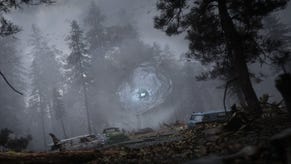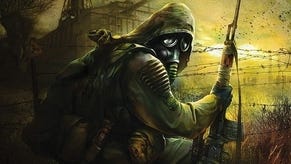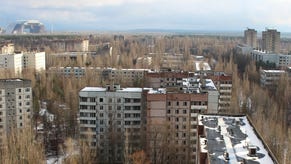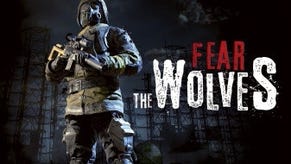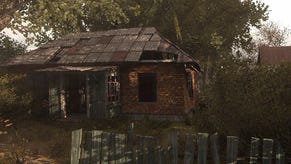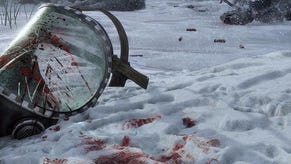S.T.A.L.K.E.R.: Shadow Of Chernobyl
In the zone.
I feel like I should warn people off Stalker. It's a grim beast, with rough animation and that laggy, about-to-explode feeling you get from some less polished PC games. It's really hard in places, and half the text is gibberish. Worse still, it's going to run like a tired old alcoholic on lower-spec PCs... and yet in spite of all this I simply cannot stop talking about it. All day long I've been opening MSN windows to annoyed friends and trying to explain the really awesome thing that just happened in Stalker. More importantly, perhaps, I've been trying to explain to them just what Stalker is. It's like X meets Y meets Z meets oh I wish you were playing it too.
It's an open-ended first-person shooter. Initially this appears to be something like 'Half-Life with added wideness' - a series of objectives, linear enough, lots of violence, some nice physics, and with plenty of retracing your steps. But the further you play, the more the game opens up. Instead of being an on-rails FPS where everything takes place in one carefully scripted corridor, Stalker allows plenty of scope for exploration. Occasional scripted events are dropped into your path, keeping the tension high and the narrative blooming. The wide levels soon expand into huge interconnected spaces, each one randomly populated by interacting and competing factions. Could this, you wonder, be some kind of Oblivion With Kalashnikovs? Or are we just talking Boiling Point with no vehicles? All the baggage that games like Oblivion bring with them simply doesn't appear here, and it's far leaner, and more Spartan than Boiling Point. The Stalker lives a simpler existence: you fight the locals, and the local fauna, completing missions given to you by the various characters you encounter along the journey. Occasionally you'll hallucinate. You gain the trust of some folks, and the ire of others. It's all very shooty: killing comes first, other stuff second. It's not a bad FPS, despite the wobbly Counter-Strike-variant feel to the combat. And it's not really an RPG, despite the amount of time spent poking about on your inventory screen, map, and mission log, and the amount of time dealing with different factions. There's something different about Stalker. It's almost as if the most important aspect of it is not combat, or interaction, or story-telling, but survival.
But perhaps the precise position of this oddity on the proverbial Venn diagram of overlapping genre conventions isn't really important. What is important is the atmosphere.
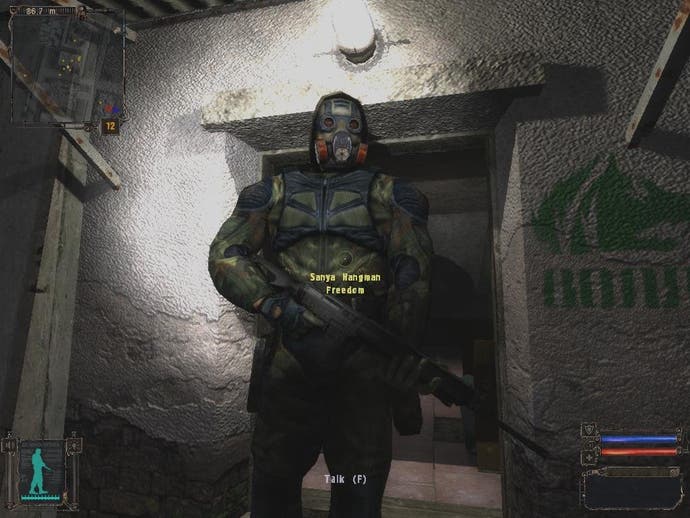
This is a singularly bleak vision. The game takes place in a kind of radiation-warped ramshackle apocalypse. It's a world that constantly exudes feelings of gloom and dread. This particular experience is practically unparalleled in gaming. If you thought Half-Life 2's derelict environments were evocative then this is like a Ukrainian mind-bomb. Stalker's terrain is, of course, ripped directly from the real-world decay of the Chernobyl exclusion zone. The tract of Soviet-era Ukraine that was cordoned off after the nuclear disaster of April 1986 has been transformed, with a potent dose of artistic licence, into gamespace. It's been chopped into a slightly more game-friendly geography, so that the most interesting areas of Chernobyl mapped by the team make up the game's numerous vast levels. Each of these areas is littered with the wreckage of life before the disaster - buildings decomposing and collapsing, trees withering and disintegrating, the clouds rushing wildly overhead. You Geiger counter crackles ominously, and occasionally even your vision begins to suffer. So yes, this is what is most crucial: atmosphere. No other game broods and rumbles like Stalker. The buildings, which do exist out there in the real world, are brutalist monuments to Soviet failure. Rotting train-yards, shattered factories, burned hospitals - bleak visions of the accidental ruin that decomposes in the heart of the Ukraine. Added to this is a powerful dose of science fiction: weird anomalous zones litter the landscape. Sometimes these dangers are mere radiation, but other times they're energy fissures or reverse gravity wells. Warped dogs and monstrous boars roam the wild spaces, and they'll tear you to pieces if you give them the slightest chance. Threatening noises echo across Stalker's damaged spaces, sometimes they're nothing, other times they're the snarl of a mutated abhorrence that has been lying in wait for you. Your job is to survive out there, to have enough food, to have enough ammunition, to avoid dying of radiation poisoning. It's darkly thrilling.
While the physical spaces rely on the bleakness of Chernobyl for their authenticity, the game's fiction takes its inspiration from the novella 'Roadside Picnic', by Arkady and Boris Strugatsky. The novel tells of an mysterious event, where something strikes the Earth from space, leaving various contaminated zones across the world. The zones are filled with weird dangers, but also produce wondrous artefacts which certain desperate people, the Stalkers, attempt to retrieve. The novella's title is based on a metaphor by the character Dr. Valentin Pilman, who compares the alien contamination to the contamination caused by an everyday roadside picnic. After the people have departed from a picnic, the doctor suggests, local animals encounter human garbage that litters the area. The things they discover are alien to them, and often dangerous - like sweet wrappers and motor oil. With the event of the zones, humankind faces the same situation as those animals: something incomprehensible has visited the Earth and its presence has left behind zones of danger that we cannot hope to understand.

Visually, Shadow Of Chernobyl is reminiscent of a film that was inspired by the same book, Andrei Tarkovsky's Stalker, which was filmed in a derelict hydro-power plant in Estonia. These two nightmarish Russian fictions are as important to Stalker's purpose and atmosphere as Chernobyl itself. Placing the ideas of these Russian artists within the man-made horror of the reactor accident is in itself a evocative piece of game design. Stalker is partly alien incomprehension, partly Soviet mystery, partly videogame artifice, and partly the real, scarred world of 2006. These ingredients combine to produce some of gaming's most potent experiences.
Early on in the story I was trying to find my way past a group of well-armed bandits. As night fell I circled their position. I could not get too close, since I was low on ammo, and my weapon was only a sawn-off shotgun anyway. It began to rain, and then thunder and lightning opened up, doing a haywire strobe light on the landscape. As I moved through the dark heaps of wasted masonry I saw movement: large things ahead of me in the valley. In the rain and dark I would not have seen them, except for the lightning. I sat there in the rain, terrified, watching these things move through dead scrubland. Should I just wait for morning? Could I just sit here in the rain, hiding behind some smashed concrete? At least that would be less terrifying that going onwards. I waited for a long time, paralysed with indecision. Finally the things made the decision for me: they closed, attacked, and ended the moment with a brutal close-range fight. I stumbled backwards into a nearby anomaly - my gravity-fluked corpse danced around in a tree.


